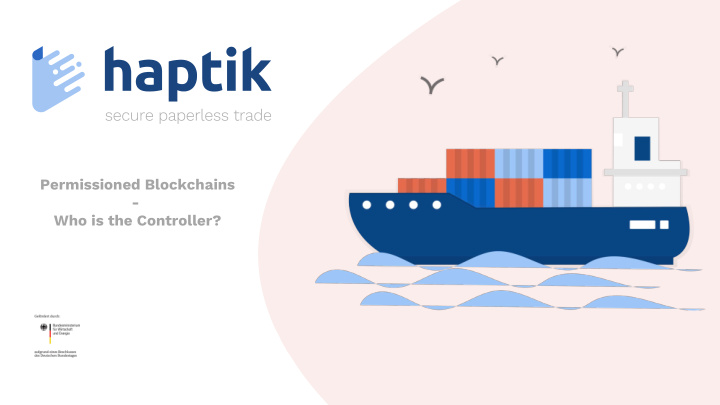



Permissioned Blockchains - Who is the Controller?
Permissioned Blockchains Re-centralization of Blockchain and its consequences for data protection agenda Controllers and the GDPR How do we apply a centralized regulation on a decentralized network? David Saive, Universität Oldenburg | haptik.io Consequences for the usage of Blockchain How is the GDPR affected by corporate law? 2
Private and permissioned Blockchains Re-centralization in a distributed world Gatekeeper Permissioned Blockchain Private Blockchain 3
Private and permissioned Blockchains Gatekeeping and authorization certificate access and exchange permission transaction data persons/companies No direct transaction exchange between gatekeeper and blockchain! 4
GDPR‘s definition of data control Art. 4 Nr. 7 GDPR The natural or legal person, public authority, agency or other body which, alone or jointly with others, determines the purposes and means of the processing of personal data 5
GDPR‘s definition of data control The ECJ‘s opinions Broad definition of the concept of ‘controller’, effective and complete protection of data subjects C-131/12, par. 34 (Google Spain) However, a natural or legal person who exerts influence over the processing of personal data, for his own purposes, and who participates, as a result, in the determination of the purposes and means of that processing, may be regarded as a controller C-25/17, par. 68 (Jehova‘s Witnesses) Rather normative approach! 6
Using a blockchain for data processing Decisions about the purpose and means People/companies decide to: 1. Digitize a certain use case 2. Use a blockchain for that use case 3. Use a specific blockchain architecture 4. Use a central instance if they opt for a permissioned blockchain 5. Process specific personal data 7
Who controlls a permissioned blockchain? No data processing without a controller 1. Software developer? 2. Gatekeeper as controller? 3. Joint control between all the nodes? 4. Joint control between gatekeeper and all nodes? 5. Legal entity that is formed by nodes? 8
Who controlls a permissioned blockchain? Software developer?! • Software developer creates the underlying implementation for a blockchain-based network Creates the means of data processing, but does not decide on it! 9
Who controlls a permissioned blockchain? Gatekeeper as single controller?! • Gatekeeper manages access to and permissions inside a blockchain-based network In general, gatekeepers do not decide on the purpose of the blockchain, but only on who is allowed to enter and participate. 10
GDPR‘s definition of data control Joint control, Art. 26 GDPR Where two or more controllers jointly determine the purposes and means of processing, they shall be joint controllers 11
GDPR‘s definition of data control The ECJ‘s opinion on joint control Furthermore, the joint responsibility of several actors for the same processing, under that provision, does not require each of them to have access to the personal data concerned ( C-40/17, par. 69 (FashionID) 12
Who controlls a permissioned blockchain? Joint control between all nodes?! • Together, the nodes form the network itself In Public Blockchains nodes only decide on a transactional basis and not on the whole network’s purpose. In Permissioned Blockchains a joint decision can be made about the use of a Blockchain for a specific use case. 13
Who controlls a permissioned blockchain? Joint control between gatekeeper and nodes? Only, if there is a specific agreement on the purpose of the blockchain between nodes and gatekeeper „We want to use a blockchain for our use case!“ 14
Who controls a permissioned blockchain? Legal entity that is formed by nodes? Two options possible: 1. Persons/companies form a legal entity in the first step • Legal entity decides to digitize a specific use case with a blockchain together with all persons/companies it includes (accessoriness) • Joint control between legal entity and all parties/nodes included 15
Who controls a permissioned blockchain? Legal entity that is formed by nodes? Two options possible: 2. Persons/companies form a legal entity by creating a blockchain • GbR/general partnership through sole participation • Duty to erect and maintain the blockchain • Joint control between all nodes • (P) Do the parties really want to set up a legal entity? 16
17
Recommend
More recommend